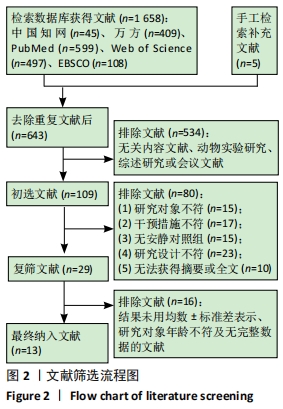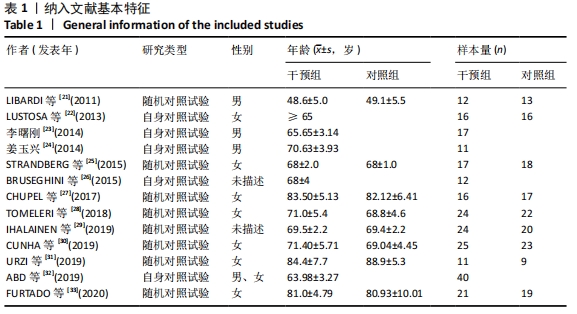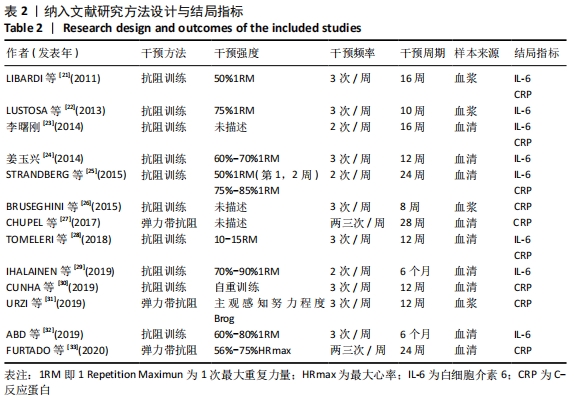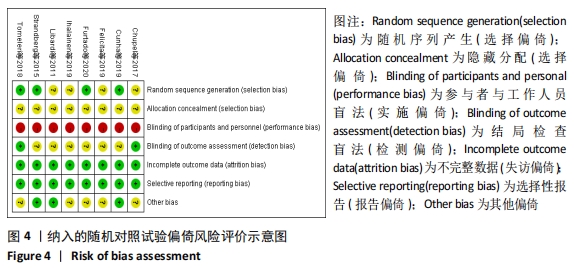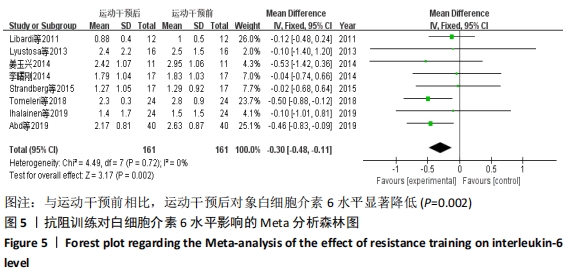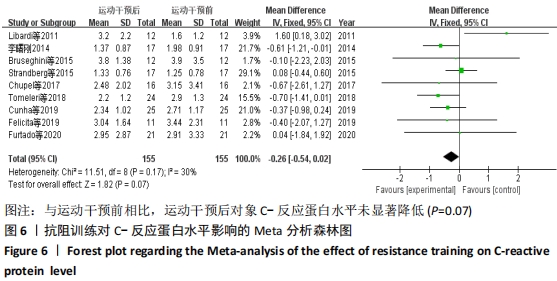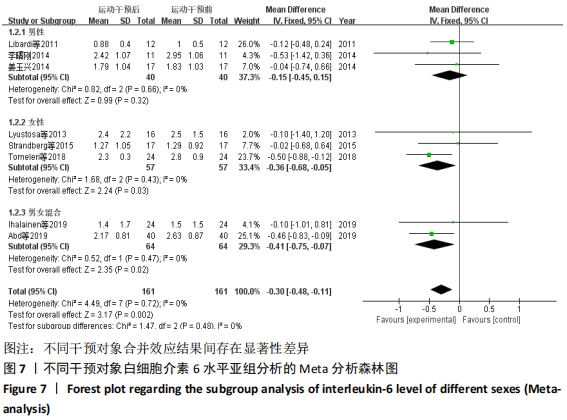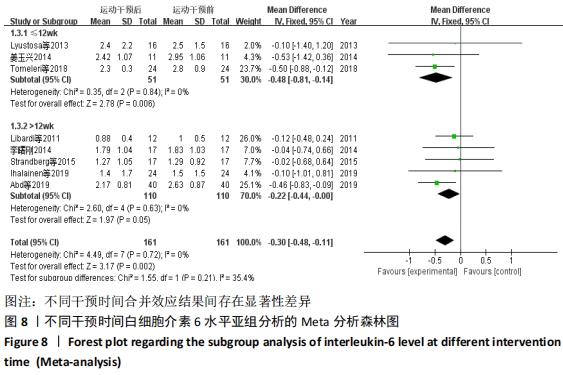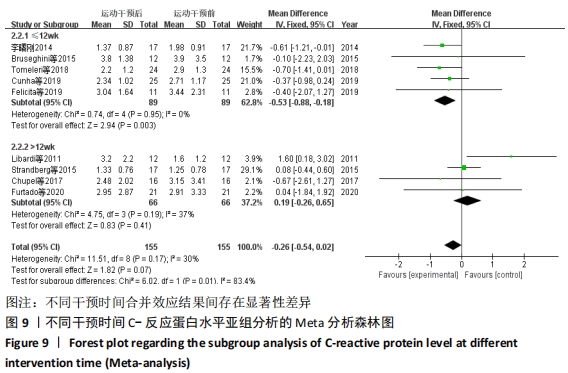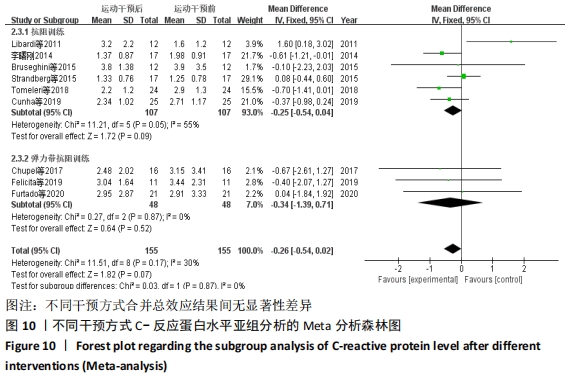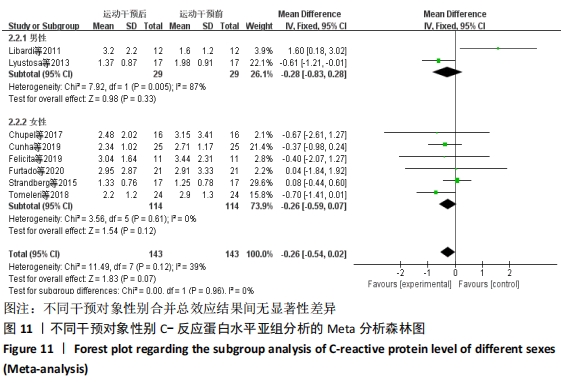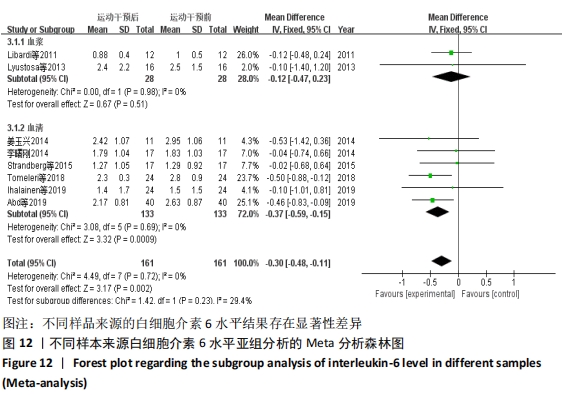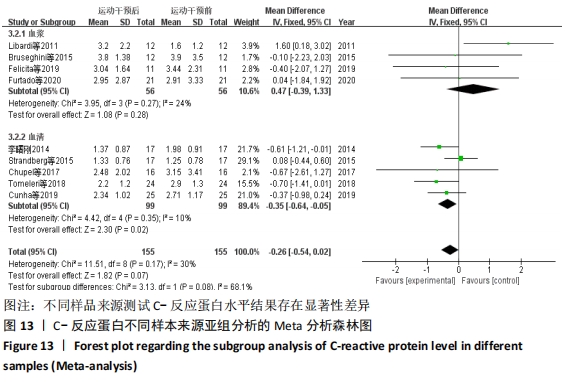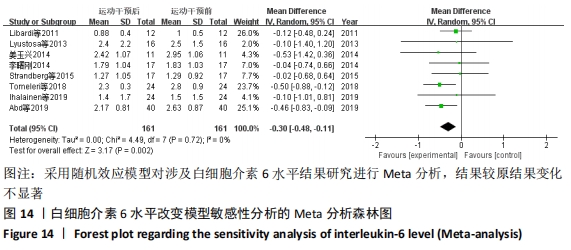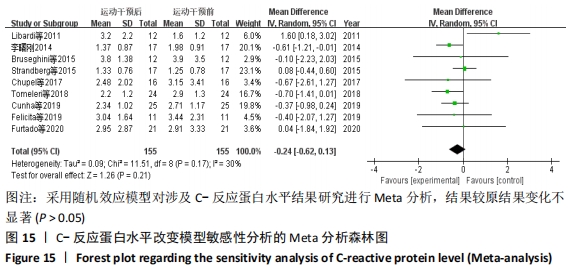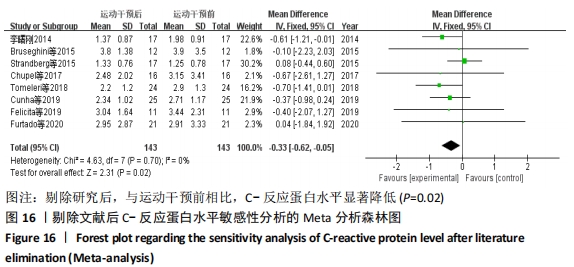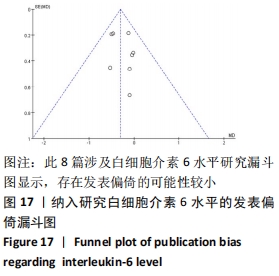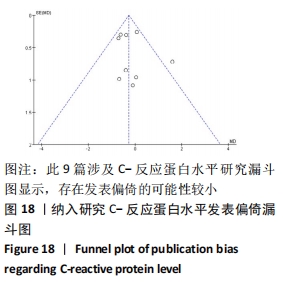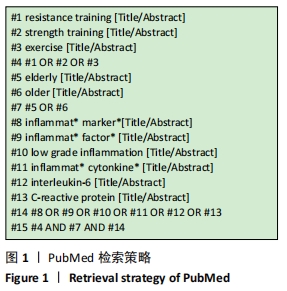[1] 孙景权,上官若男,严翊,等.心肺适能和炎症标志物的相关性及其机制的研究进展[J].中国康复医学杂志,2016,31(2):228-234.
[2] SINGH T, NEWMAN AB. Inflammatory markers in population studies of aging. Ageing Res Rev. 2011;10(3):319-329.
[3] NOORDAM R, OUDT CH, BOS MM, et al. High-sensitivity c-reactive protein, low-grade systemic inflammation and type 2 diabetes mellitus: a two-sample Mendelian randomization study. Nutr Metab Cardiovasc Dis. 2018;28(8):795-802.
[4] AGCA R, HESLINGA SC, HALM VP, et al. Atherosclerotic cardiovascular disease in patients with chronic inflammatory joint disorders. Heart. 2016;102(10):790-795.
[5] GROSICKI GJ, BARRETT BB, ENGLUND DA, et al. Circulating interleukin-6 is associated with skeletal muscle strength, quality, and functional adaptation with exercise training in mobility-limited older adults. J Fraility Aging. 2020;9(1):57-63.
[6] SWERDLOW ID, HOLMES MV, KUCHENBAECKER KB, et al. The interleukin-6 receptor as a target for prevention of coronary heart disease: a mendelian randomisation analysis. Lancet. 2012; 379(9822):1214-1224.
[7] 刘国华,盛迪晔.渐进式抗阻训练延缓骨骼肌衰减的Meta分析[J].内江师范学院学报,2018, 33(8):107-115.
[8] 郑丽,李冬咏,李金虎,等.弹力带抗阻训练在老年患者下肢肌肉力量训练中的应用效果[J].安徽医学,2019,40(2):219-222.
[9] TAKENAMI E, IWAMOTO S, SHIRAISHI N, et al. Effects of low-intensity resistance training on muscular function and glycemic control in older adults with type 2 diabetes. J Diabetes Investig. 2019;10(2):331-338.
[10] PAULA AMC, RICA RL, EVANGELISTA AL, et al. Effects of exercise intensity on post exercise hypotension after resistance training session in overweight hypertensive patients. Clin Interv Aging. 2015;10:1487-1495.
[11] FORTI LN, NJEMINI R, BEYER I, et al. Strength training reduces circulating interleukin-6 but not brain-derived neurotrophic factor in community-dwelling elderly individuals. AGE. 2014;36(5):9704.
[12] TOMELERI CM, SOUZA MF, BURINIR C, et al. Resistance training reduces metabolic syndrome and inflammatory markers in older women: a randomized controlled trial. J Diabetes. 2017; 10(4):328-337.
[13] EL-KADER SMA, AL-SHREEF FM. Inflammatory cytokines and immune system modulation by aerobic versus resisted exercise training for elderly. Afr Health Sci. 2018;18(1):120-131.
[14] BEAVERS KM, HSU FC, ISOM S, et al. Long-term physical activity and inflammatory biomarkers in older adults. Med Sci Sports Exerc. 2010;42(12):2189-2196.
[15] KARABULUT M, SHERK VD, BEMBEN DA, et al. Inflammation marker, damage marker and anabolic hormone responses to resistance training with vascular restriction in older males. Clin Physiol Funct Imaging. 2013;33(5):393-399.
[16] MONTEIRO-JUNIOR RS, MACIEL-PINHEIRO PT, PORTUGAL EDM, et al. Effect of exercise on inflammatory profile of older persons: systematic review and meta-analyses. J Phys Act Health. 2018;15(1):64-71.
[17] YOUSEFABAD HA, NIYAZI A, ALAEE S, et al. Anti-Inflammatory effects of exercise on metabolic syndrome patients: a systematic review and meta-analysis. Biol Res Nurs. 2020. doi: 10.1177/1099800420958068.
[18] 谷鸿秋,王杨,李卫. Cochrane偏倚风险评估工具在随机对照试验Meta分析中的应用[J].中国循环杂志,2014,29(2):147-148.
[19] JONATHAN AC, MIGUEL AH, BARNABY CR, et al. ROBINS-I: a tool for assessing risk of bias in non-randomised studies of interventions. BMJ. 2016;355:i4919.
[20] 吴旸,李倩,包大鹏.加压力量训练对下肢骨骼肌影响的Meta分析[J].中国体育科技,2019, 55(3):20-26.
[21] LIBARDI CA, SOUZA GV, GÁSPARI AF, et al. Effects of concurrent training on interleukin-6, tumour necrosis factor-alpha and C-reactive protein in middle-aged men. J Sports Sci. 2011; 29(14):1573-1581.
[22] LUSTOSA LP, MÁXIMO PEREIRA, LEANI S, et al. Impact of an exercise program on muscular and functional performance and plasma levels of interleukin 6 and soluble receptor tumor necrosis factor in prefrail community-dwelling older women: a randomized controlled trial. Arch Phys Med Rehab. 2013;94(4):660-666.
[23] 李曙刚,周园.抗阻训练对老年人肌肉含量与血清炎症因子水平的影响[J].中国老年学杂志, 2014,34(23):6659-6661.
[24] 姜玉兴,王戌楼,李伟,等.力量训练对老年男性增龄性肌萎缩及慢性炎症的影响[J].中国康复理论与实践,2014,20(7):645-650.
[25] STRANDBERG E, EDHOLM P, PONSOT E, et al. Influence of combined resistance training and healthy diet on muscle mass in healthy elderly women : a randomized controlled trial. J Appl Physiol. 2015;119(8):918-925.
[26] BRUSEGHINI P, CALABRIA E, TAM E, et al. Effects of eight weeks of aerobic interval training and of isoinertial resistance training on risk factors of cardiometabolic diseases and exercise capacity in healthy elderly subjects. Oncotarget. 2015;6(19):16998-17015.
[27] Chupel MU, Direito F, Furtado GE, et al. Strength training decreases inflammation and increases cognition and physical fitness in older women with cognitive impairment. Front Physiol. 2017;8:377.
[28] TOMELERI CM, RIBEIRO AS, CAVAGLIERI CR, et al. Correlations between resistance training-induced changes on phase angle and biochemical markers in older women. Scand J Med Sci Sports. 2018;28(10):2173-2182.
[29] IHALAINEN JK, INGLIS A, MAKINEN T, et al. Strength training improves metabolic health markers in olderindividual regardless of training frequency. Front Physiol. 2019;(10):32.
[30] CUNHA PM, RIBEIRO AS, NUNES JP, et al. Resistance training performed with single-set is sufficient to reduce cardiovascular risk factors in untrained older women: the randomized clinical trial: active aging longitudinal study. Arch Gerontol Geriatr. 2019;81:171-175.
[31] URZI F, MARUSIC U, LIčEN S, et al. Effects of elastic resistance training on functional performance and myokines in older women-a randomized controlled trial. J Am Med Dir Assoc. 2019;20(7):830-834.
[32] ABD ESM, AL-SHREEF FM, AL-JIFFRI OH. Impact of aerobic exercise versus resisted exercise on endothelial activation markers and inflammatory cytokines among elderly. Afr Health Sci. 2019;9(4): 2874-2880.
[33] FURTADO G, CHUPEL MU, MINUZZI L, et al. The mediating effect of different exercise programs on the immune profile of frail older women with cognitive impairment. Curr Pharm Des. 2020;26: 1-10.
[34] JOHNSON ML, IRVING BA, LANZA IR, et al. Differential effect of endurance training on mitochondrial protein damage, degradation, and acetylation in the context of aging. J Gerontol A Biol Sci Med Sci. 2015;70(11):1386-1393.
[35] FEDEWA MV, HATHAWAY ED, WARD-RITACCO CL. Effect of exercise training on C reactive protein: a systematic review and meta-analysis of randomised and non-randomised controlled trials. Br J Sports Med. 2017;51(8):bjsports-2016- 095999.
[36] AMORIM MGS, OLIVEIRA MD, SOARES DS, et al. Efects of exergaming on cardiovascular risk factors and adipokine levels in women. J Physiol Sci. 2018; 68(5):671-678.
[37] UNAMUNO X, GÓMEZ-AMBROSI J,
RODRÍGUEZ A, et al. Adipokine dysregulation and adipose tissue inflammation in human obesity. Eur J Clin Invest. 2018;48(9):e12997.
[38] XIA Z, CHOLEWA J, ZHAO Y, et al. Targeting inflammation and downstream protein metabolism in sarcopenia: a brief up-dated description of concurrent exercise and leucine-based multimodal intervention. Front Physiol. 2017;8:434.
[39] ELHAKEEM A, MURRAY ET, COOPER R, et al. Leisure-time physical activity across adulthood and biomarkers of cardiovascular disease at age 60e64: a prospective cohort study. Atherosclerosis. 2018;269:279-287.
[40] IRENA S, GABRIELA RO, LORI BB. Does one size fit all? The role of body mass index and waist circumference in systemic inflammation in midlife by race and gender. Ethn Health. 2017;22(2):169-183.
[41] 王光旭.弹力带抗阻训练对老年人肌力、行走能力和生活质量影响的实验研究[D].上海:上海体育学院,2018.
[42] 王鹏,江海洋,赵超,等.不同标本类型C反应蛋白检测结果的一致性分析[J].东南国防医药,2019,21(3):254-257.
[43] 刘少峰,陈昇,黄思源,等.太极拳联合抗阻训练对55-60岁女性骨密度的疗效分析[J].安阳师范学院学报,2019(5):82-86.
[44] Brunelli DT, Chacon-Mikahil MPT, Gspari AF, et al. Combined training reduces subclinical inflammation in obese middle-age men. Med Sci Sports Exerc. 2015;47(10):2207-2215.
|

